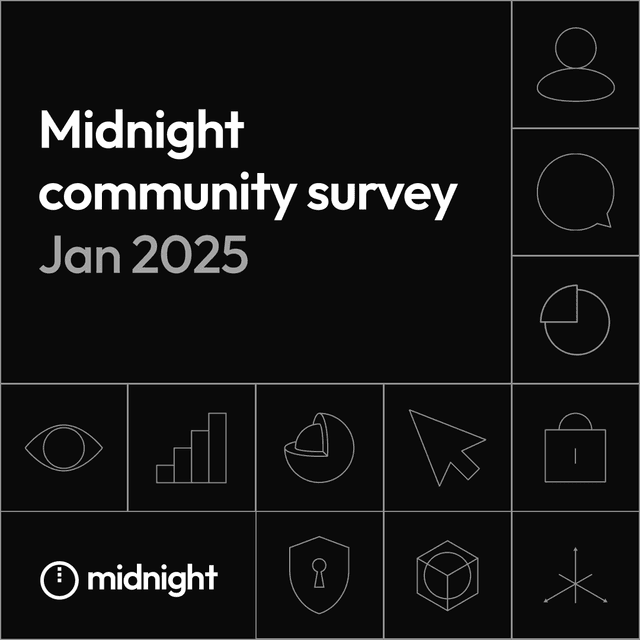The foundation of any thriving blockchain network isn't just its code or technical architecture – it's also the community of people supporting it. While the technical foundation provides the scaffolding for growth, it's the people who will determine the network's trajectory, resilience, and ultimate success.
To better understand the Midnight community, a survey was conducted in January 2025, gathering insights from hundreds of participants1. The results summarized below provide valuable direction for the network's development priorities, feature roadmap, and educational initiatives. Read on to catch a glimpse of the Midnight community as of the beginning of the year – their composition, behavior, values, challenges, and preferences.
Community composition
The survey revealed a diverse community spanning multiple demographics:
- Geographic distribution: North America (45%) and Europe (39%) represent the majority, with smaller representation from Asia (7%), Latin America (5%), Oceania (4%), and Africa (1%).
- Experience levels: 78% of respondents have identified themselves as either somewhat or very experienced with blockchain and decentralized applications, while nearly a third (32%) consider themselves beginners.
- User types: the vast majority of respondents (97%) have used decentralized applications, while 12% would describe themselves as developers.
- Motivations: just about 40% of respondents mention their involvement with Cardano as their main motivation for joining Midnight, while 25% cite their concern with privacy.
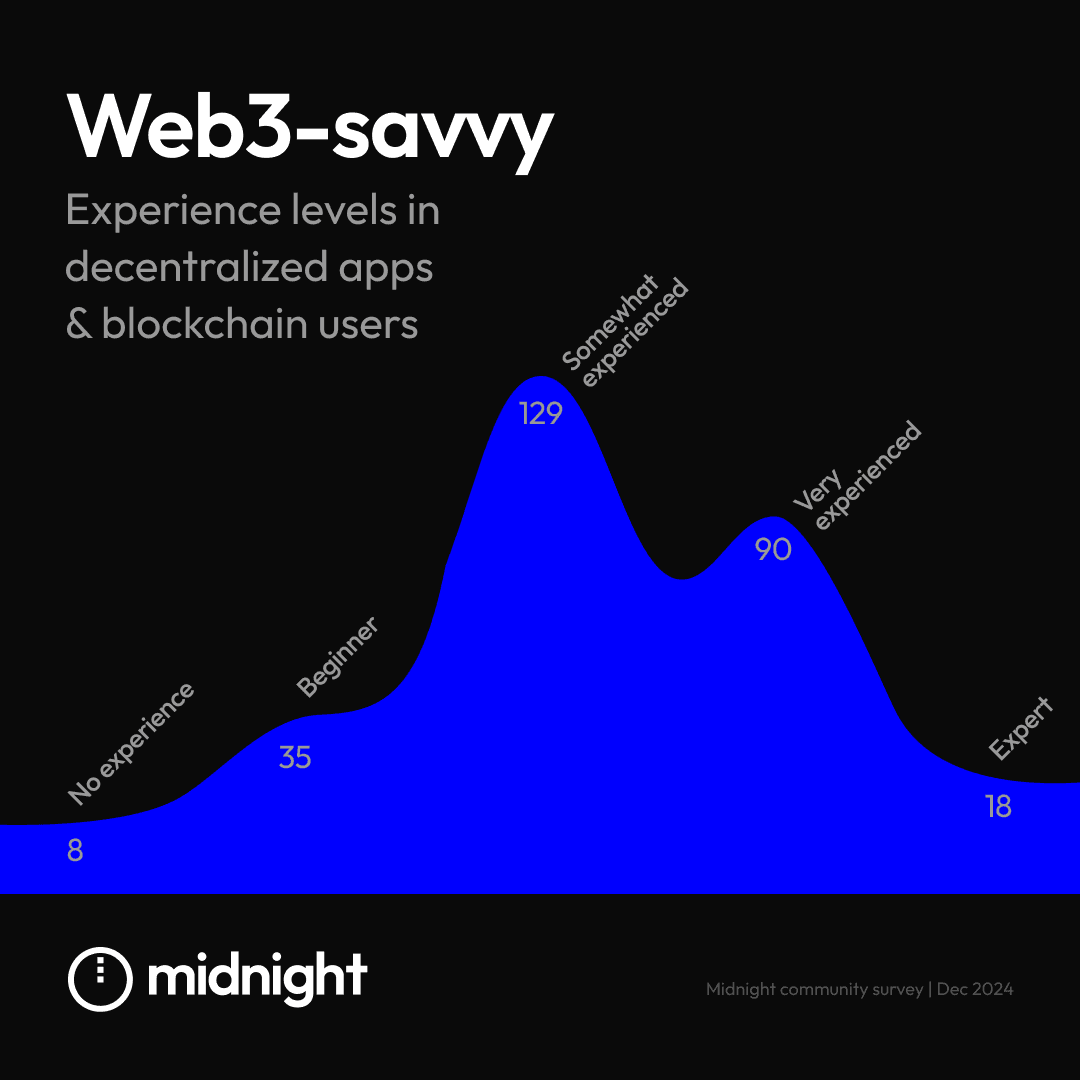
Highlight: attitudes and preferences towards privacy
Perhaps unsurprisingly, the data highlights a priority for a majority of community members is privacy and data sovereignty, with financial data being the most cited type of sensitive information to be kept safe.
- Self-sovereignty: an overwhelming 93% of all respondents said they trust themselves more than others (such as companies, governments, search engines) to manage their sensitive data. This self-trust spans all experience levels, age groups, and regions – even respondents with limited technical experience prefer self-sovereignty, but…
- Low confidence: only 40% expressed high confidence in managing their own sensitive personal data or digital credentials. This indicates that for the majority of participants, better solutions are still needed.
- Privacy concern levels: 76% expressed being "Very concerned" or "Extremely concerned" about personal data privacy.
- Sensitive information: financial data topped the list as the most sensitive information worth protecting (48%), followed by health (10%) and address data (9.6%).
- DApp concerns: security issues—specifically hacks (37%) and scams (33%)—emerged as the primary concerns when using decentralized applications.
These findings are consistent across all regions: while there is minor variation in reported privacy concerns in different regions, the majority of respondents across all regions are concerned with privacy when using apps and have low confidence in apps keeping their data secure.
Privacy paradox
Despite high expressed concerns about privacy, some protective behaviors lag behind:
- High concern, low action: 76% of respondents are "Very" or "Extremely" concerned about privacy, yet:
- Only 18% always or often read privacy policies.
- Only 20% check what data apps collect about them often or always.
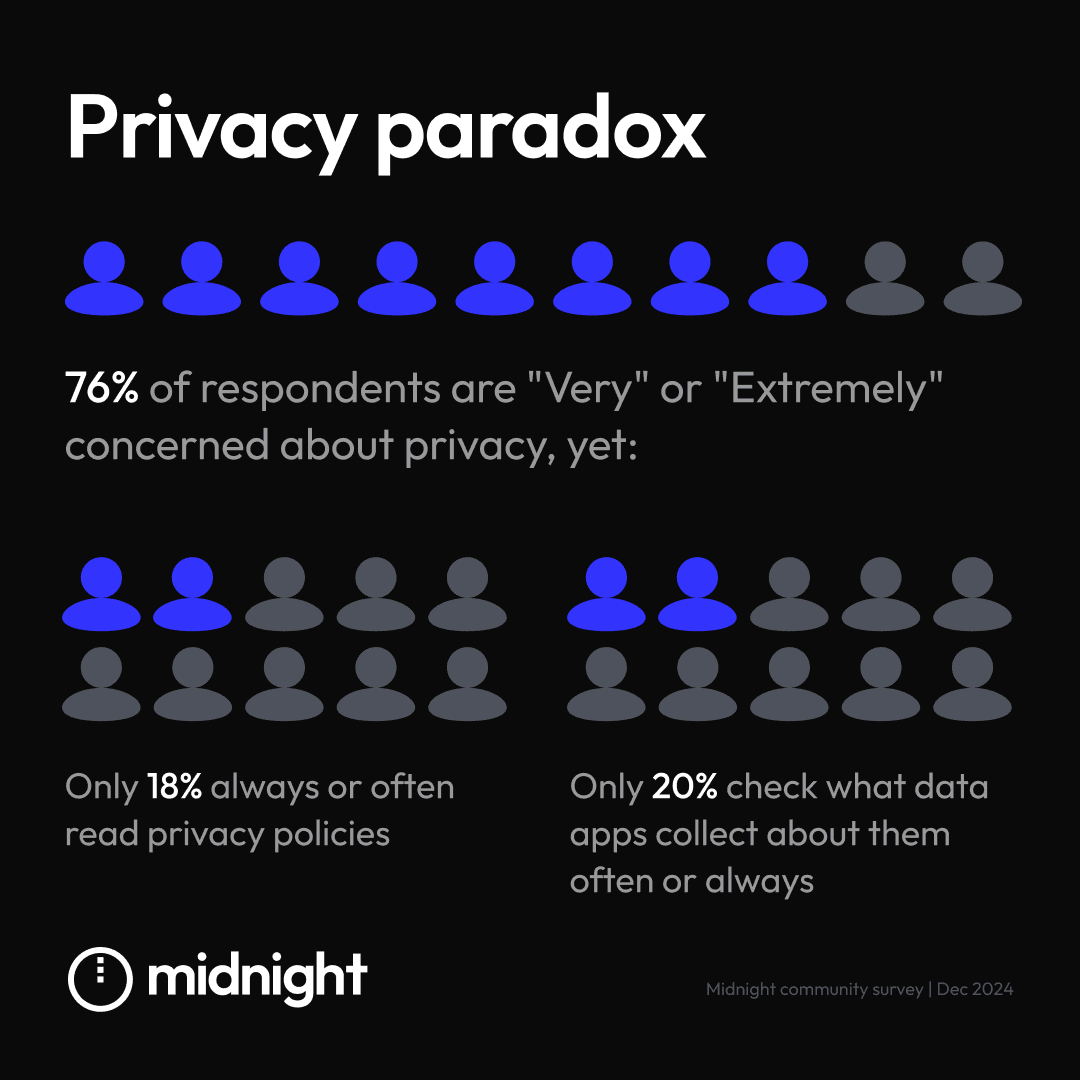
This contradiction hints at a fundamental issue with web2 applications and UX. For lack of a better solution, most apps have been created in a way that requires clunky privacy controls under arcane, ever-changing policies on even the most basic services, leading to a poor user experience and increased risk of costly data incidents.
This reveals an opportunity for Midnight developers and partners to create solutions that build in data protection by default rather than requiring significant behavior changes. Sending proofs of data (rather than data itself) and enabling fine privacy controls with selective disclosure allows app developers to create experiences that aligns their users’ expectations
DApp users
Respondents have shown that they’re very active on Web3.
- High community engagement: 73% of non-developers use DApps at least weekly, indicating an active and engaged community base.
- Experience-based adoption curve: more experienced users adopt more complex DApps, with DeFi apps showing the most dramatic difference between beginners (13%) and experts (82%). Advanced DApp categories (DeFi, NFTs, DAOs) show strong association with experience level.
- DAOs and gaming lag behind: despite interest in these categories, actual usage of DAOs (25%) and on-chain games (22%) remains relatively low, suggesting potential growth opportunities.
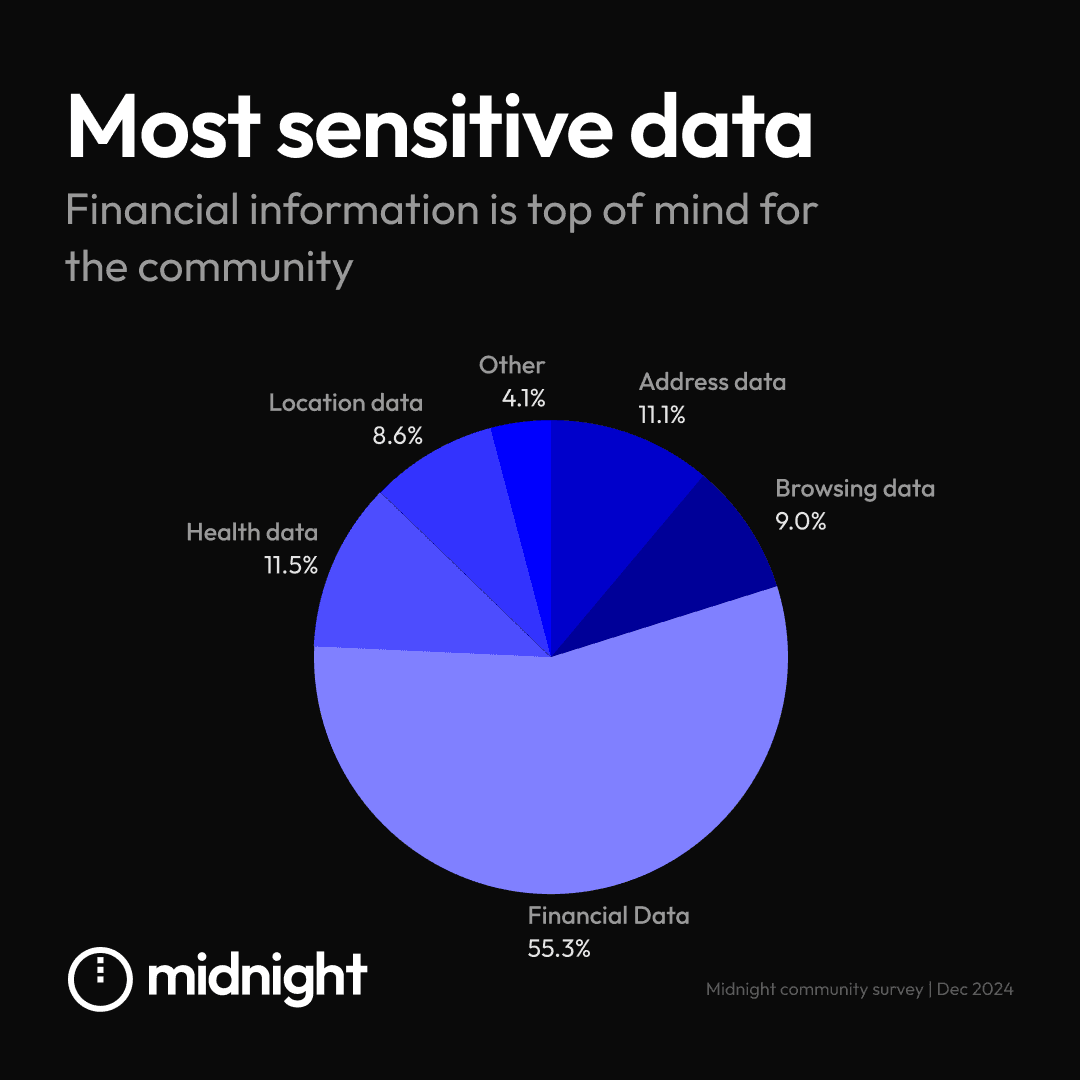
Challenges using DApps
The survey identified several obstacles that users face with decentralized technology:
- Verifying legitimacy: 56% struggle to determine whether DApps are legitimate or scams.
- Bridge navigation: 24% find it difficult to use bridges between blockchains.
- Security credential management: 12% encounter challenges managing security credentials.
Addressing these pain points could significantly improve the user experience.
Expanding community resources
These responses highlight that the Midnight community spans a wide range of experience levels, making inclusive education essential as the ecosystem continues to grow. New and existing resources aim to support both newcomers and experienced users with:
- A high-level overview of activity across the Midnight ecosystem with links to comprehensive developer resources in the State of the Network blog, which was launched in February.
- Community-focused updates in the monthly Midnight Express newsletter and across LinkedIn and X.
- In-depth discussions with highly personal support in Discord.
- Expanding Midnight documentation, with more educational content in development.
As part of the community-driven expansion of information and resources, new educational resources are rolling out in the coming months, aimed at lowering the barrier to entry and helping users of all experience levels navigate the ecosystem more confidently.
Developer perspective
The developer subset provided insights into their needs and challenges:
- Seasoned builders: majority (53%) have 3+ years of blockchain experience.
- Platform selection criteria: Security (74%), documentation (65%), and data protection (56%) top the list.
DApp development and challenges
Respondents reported on their recent experiences building Web3 applications:
- High: DeFi apps (32%), NFT marketplaces (29%), and cryptocurrency wallets (26%) lead recent development experience.
- Lower development focus on DEXes (12%), games (12%), and DAOs (only 6%).
- Development challenges: respondents have listed regulatory uncertainty (65%) and lack of developer tools/documentation (59%) as their top blockers, with security vulnerabilities (32%) and scalability issues (24%) as secondary concerns.
Supporting developers
To support developers, additional materials and resources have been released this month with more on the way. Open-source repositories offer real-world examples to build from, and the first open source repository was released this month: the example counter. Step-by-step walkthroughs guide developers through key tasks and concepts, like the recently released walkthrough building a board smart contract with Compact.
Monthly community hackathons provide hands-on experience, live support, and direct collaboration with the Midnight team. The Zero Limits hackathon is now underway and removes constraints entirely: developers can test any idea, get direct feedback, and experiment with new concepts in a supportive environment.
Midnight: most compelling use cases
When asked about Midnight's most exciting applications, respondents showed clear preferences:
- Self-sovereign digital identity (41%)
- Shielded financial transactions (27%)
- Shielded DApp usage (12%)
- Data monetization (8%)
- Anonymous data sharing (8%)
Regional differences emerged in these preferences. European users showed stronger interest in self-sovereign identity solutions (42%), while North Americans favored shielded financial transactions (30%).
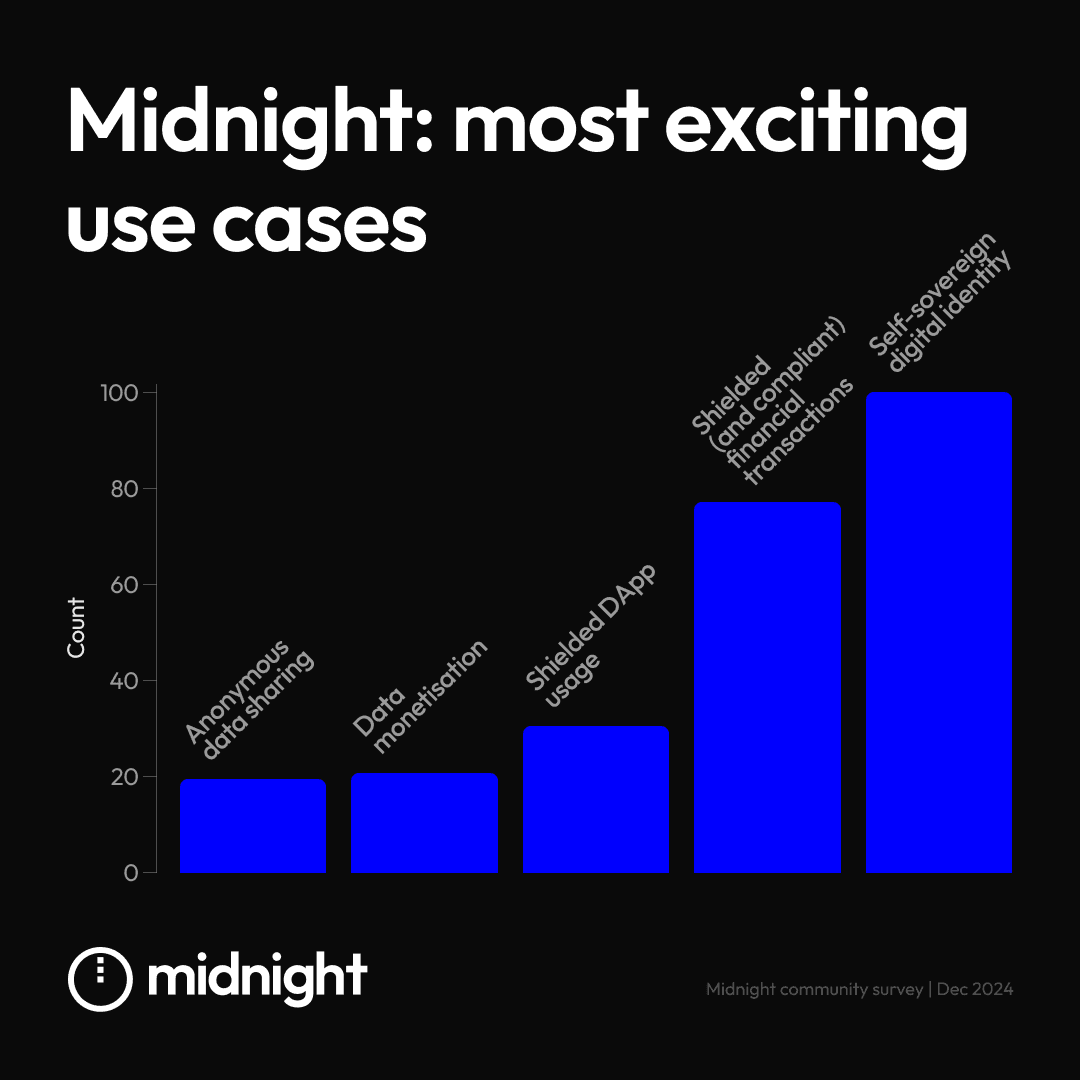
Irrespective of the use case, respondents sent a clear message that privacy and data protection isn’t enough; Midnight development should also prioritize ease of use, flexibility, balance, and security:
"Building a privacy-first blockchain isn't enough—it must be indispensable. The real challenge isn't creating privacy features but making them essential to users' daily lives. Focus on creating tools that make privacy the easiest path, not just the most secure one." (Respondent from Europe)
"To balance the need for privacy with the importance of transparency in determining what should remain private and what should be made public, and to whom, in order to combat corruption and the lack of transparency in today's financial, political, and corporate sectors." (Respondent from Latin America & Caribbean)
Ongoing engagement
This survey represents just the beginning of an ongoing dialogue that will help shape the future of digital privacy and data ownership through the Midnight network. The conversation doesn't end with this survey. You can continue to contribute by:
- Sharing thoughts on these findings in the Midnight Discord server
- Participating in upcoming community calls and events
- Providing feedback on specific features as they're developed
1: Note: While this survey provides valuable direction, the sample size (280 respondents) represents only a portion of the broader community. Additional feedback channels will be used to ensure comprehensive understanding of community needs.

